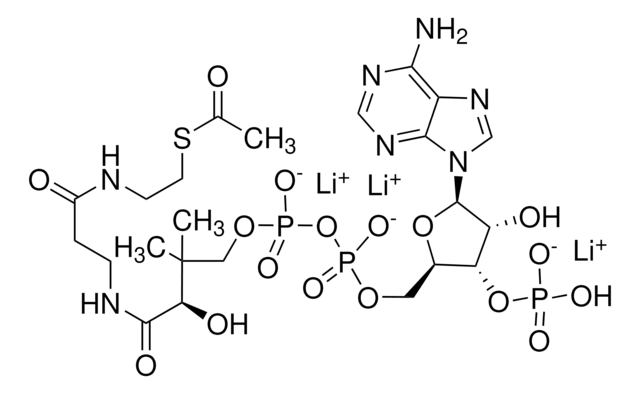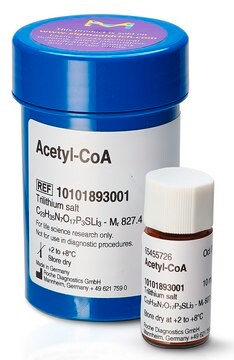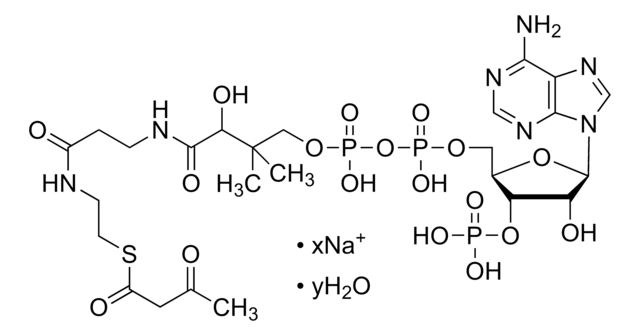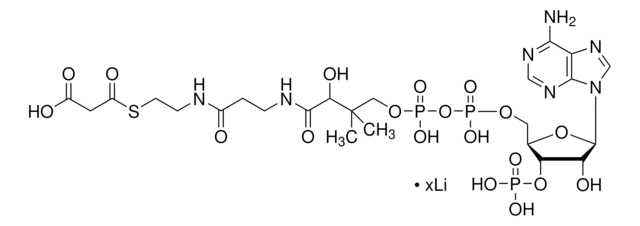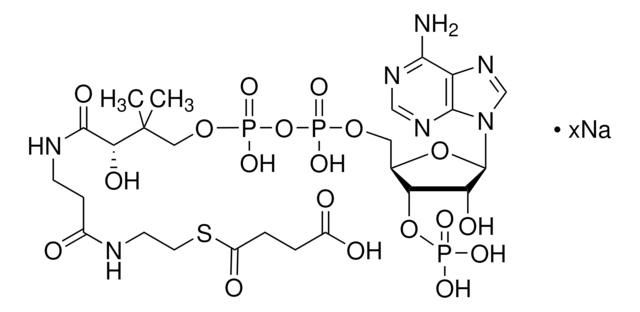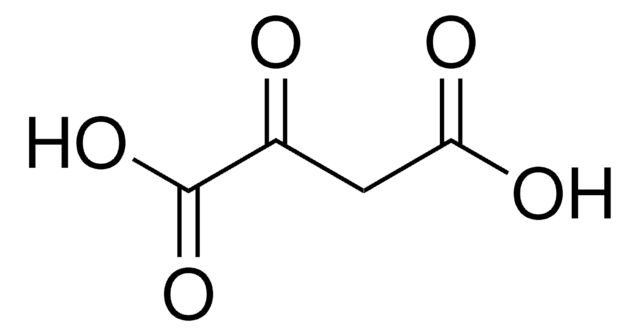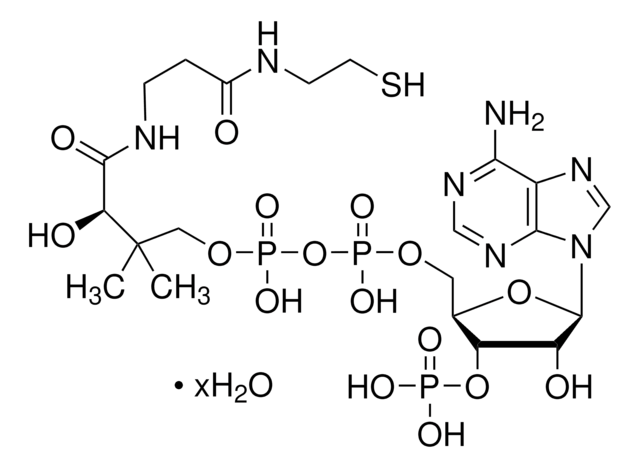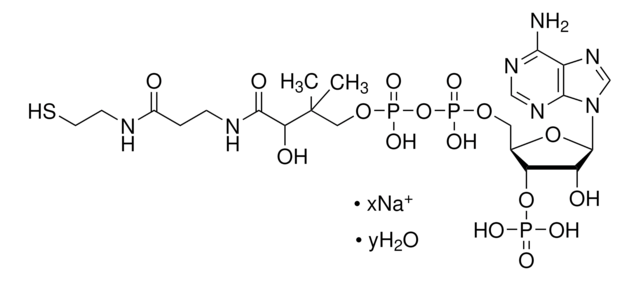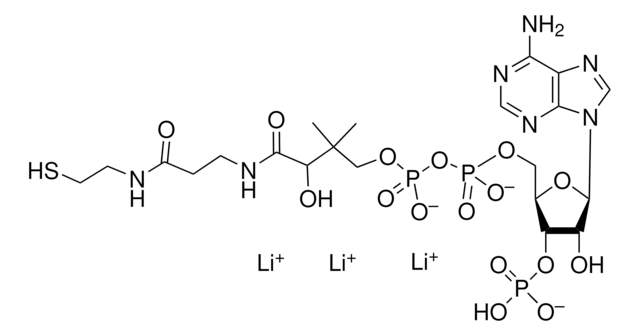推荐产品
检测方案
≥93% (HPLC)
形式
powder
溶解性
H2O: 100 mg/mL
储存温度
−20°C
SMILES字符串
O[C@H]1[C@](O[C@@H]([C@H]1OP(O)(O)=O)COP(OP(OCC(C)(C)[C@@H](O)C(NCCC(NCCSC(C)=O)=O)=O)(O)=O)(O)=O)([H])N2C3=NC=NC(N)=C3N=C2.[3Na]
InChI
1S/C23H38N7O17P3S.Na/c1-12(31)51-7-6-25-14(32)4-5-26-21(35)18(34)23(2,3)9-44-50(41,42)47-49(39,40)43-8-13-17(46-48(36,37)38)16(33)22(45-13)30-11-29-15-19(24)27-10-28-20(15)30;/h10-11,13,16-18,22,33-34H,4-9H2,1-3H3,(H,25,32)(H,26,35)(H,39,40)(H,41,42)(H2,24,27,28)(H2,36,37,38);/q;+1/p-1/t13-,16-,17-,18?,22-;/m1./s1
InChI key
HNLIOWFIXSPFEC-WLYMNMRISA-M
基因信息
human ... CHAT(1103) , HAT1(8520) , KAT2A(2648) , KAT2B(8850) , KAT5(10524)
mouse ... HAT1(107435) , KAT2A(14534) , KAT2B(18519) , KAT5(81601)
rat ... HAT1(296501) , KAT2A(303539) , KAT2B(301164) , KAT5(192218)
正在寻找类似产品? Visit 产品对比指南
应用
生化/生理作用
制备说明
其他说明
储存分类代码
11 - Combustible Solids
WGK
WGK 3
闪点(°F)
Not applicable
闪点(°C)
Not applicable
个人防护装备
Eyeshields, Faceshields, Gloves, type N95 (US)
分析证书(COA)
输入产品批号来搜索 分析证书(COA) 。批号可以在产品标签上"批“ (Lot或Batch)字后找到。
已有该产品?
为方便起见,与您过往购买产品相关的文件已保存在文档库中。
难以找到您所需的产品或批次号码?
如何查找产品货号
在网站页面上,产品编号会附带包装尺寸/数量一起显示(例如:T1503-25G)。请确保 在“产品编号”字段中仅输入产品编号 (示例: T1503).
示例
其它示例:
705578-5MG-PW
PL860-CGA/SHF-1EA
MMYOMAG-74K-13
1000309185
输入内容 1.000309185)
遇到问题?欢迎随时联系我们技术服务 寻求帮助
如何查找COA批号
批号可以在产品标签上"批“ (Lot或Batch)字后面找到。
Aldrich 产品
如果您查询到的批号为 TO09019TO 等,请输入去除前两位字母的批号:09019TO。
如果您查询到的批号含有填充代码(例如05427ES-021),请输入去除填充代码-021的批号:05427ES。
如果您查询到的批号含有填充代码(例如 STBB0728K9),请输入去除填充代码K9的批号:STBB0728。
未找到您寻找的产品?
部分情况下,可能未在线提供COA。如果搜索不到COA,可在线索取。
Which document(s) contains shelf-life or expiration date information for a given product?
If available for a given product, the recommended re-test date or the expiration date can be found on the Certificate of Analysis.
How do I get lot-specific information or a Certificate of Analysis?
The lot specific COA document can be found by entering the lot number above under the "Documents" section.
How do I find price and availability?
There are several ways to find pricing and availability for our products. Once you log onto our website, you will find the price and availability displayed on the product detail page. You can contact any of our Customer Sales and Service offices to receive a quote. USA customers: 1-800-325-3010 or view local office numbers.
What is the Department of Transportation shipping information for this product?
Transportation information can be found in Section 14 of the product's (M)SDS.To access the shipping information for this material, use the link on the product detail page for the product.
What is the formula weight for the Product No. A2056, Acetyl Coenzyme A?
The formula weight for the Product No. A2056, Acetyl Coenzyme A, as reported on the website is for the free base with a weight of 809.57 daltons.
For Product No. A2056, Acetyl Coeznyme A, why is the formula weight listed on the website and the formula weight listed on the label different?
The difference in the formula weights reported for Product No. A2056, Acetyl Coenzyme A, on the website versus the label is due to the sodium and water content of the product which may vary from lot to lot. The formula weight of the free base is reported on the website, however on the label, variations in sodium and water content will reflect differences in formula weights reported on the label for a specific lot of product.
What is the solution stability for the A2056, Acetyl Coenzyme A?
The solution stability is reported as followed: A solution of the product can be stored in neutral buffer or below (pH 3-7) for no longer than two weeks at -20°C when divided into aliquots. This is recommended for keeping the solution stable. It would be better to prepare fresh solutions and use soon after.
My question is not addressed here, how can I contact Technical Service for assistance?
Ask a Scientist here.
商品
Sigma-Aldrich presents an article about how proliferatively active cells require both a source of carbon and of nitrogen for the synthesis of macromolecules. Although a large proportion of tumor cells utilize aerobic glycolysis and shunt metabolites away from mitochondrial oxidative phosphorylation, many tumor cells exhibit increased mitochondrial activity.
This is an article about how proliferatively active cells require both a source of carbon and of nitrogen for the synthesis of macromolecules. Although a large proportion of tumor cells utilize aerobic glycolysis and shunt metabolites away from mitochondrial oxidative phosphorylation, many tumor cells exhibit increased mitochondrial activity.
Get to know the Tricarboxylic acid (TCA) cycle to better inform your research in biochemistry, metabolomics, or related fields concerned with this metabolic pathway and its enzymes, by-products, or intermediates.
Get to know the Tricarboxylic acid (TCA) cycle to better inform your research in biochemistry, metabolomics, or related fields concerned with this metabolic pathway and its enzymes, by-products, or intermediates.
实验方案
This procedure applies to products that have a specification for the enzymatic activity of chloramphenicol acetyltransferase.
Enzymatic Assay of Chloramphenicol Acetyltransferase
我们的科学家团队拥有各种研究领域经验,包括生命科学、材料科学、化学合成、色谱、分析及许多其他领域.
联系技术服务部门